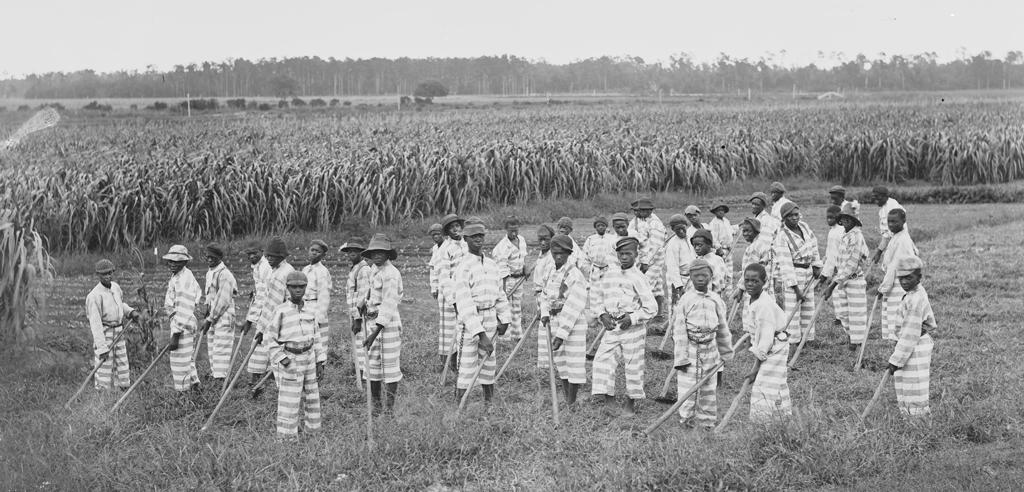(The TCJC Convict Leasing & Labor Project and Spectrum Fusion Collaboration)
“Accountability, compassion, dignity, diversity, equity, fairness, forgiveness, innovation, justice, potential, and respect;” these are the core values that are at the heart of the “Texas Criminal Justice Coalition.” Established over 20 years ago, originally as the TCJRC (Texas Criminal Justice Reform Coalition), the TCJC functions as a nonprofit organization that seeks to improve the lives of Texas citizens through analysis and reformations of the Texas criminal justice system with the primary goal of reducing the number of convictions within the Texas judicial system. To put it in simpler terms; the TCJC works to help Texas communities by bringing changes to the current legal system and promoting public safety. By reaching out to various communities and establishing interpersonal connections, the TCJC addresses the problematic components of the current legal system and works to provide solutions using the relationships they have established and the meaningful stories shared by everyday citizens as a foundation on which to build a solid solution to glaring problems. From forming policies to improve the lives of citizens released from prison to promoting prison closure as a method of obtaining funding, the Texas Criminal Justice Coalition has established itself as a reputable organization that constantly works to bring equality, opportunity, and productivity to every individual that comes into contact with the Texas legal system.
Introduction of Mr. Reginald Moore & Convict Leasing
It is this dedication to social equality through the reformation of the judicial system that drew the attention of Mr. Reginald Moore to the TCJC. In 1985, as a guard for Jester State Prison Farm, in Richmond, Mr. Moore witnessed the failings of the current criminal justice system. During the apex of the “Crack Epidemic,” Reginald saw first hand how even the smallest criminal offense ensnared people into a “revolving door” system where they find themselves back in jail even after being released. Appalled by this broken system Reginald Moore began his search to find connections between the slavery systems of the past and the modern justice system. Reginald Moore believed that it is possible to change broken systems, like the one in Richmond, by revealing how modern judicial systems and laws are connected to the discriminative ones of the past. This quest led Mr. Moore to an important discovery when he came across a collection of documents from the late 1880s to the early 1900s. These documents revealed a grim chapter in Texas history that has gone unnoticed by the general public, spoken only within the small communities of African-Americans that are still recovering from the misfortune brought about by this forgotten chapter.
The 16 documents found by Mr. Reginald Moore revealed a meticulously calculated enterprise in a now-illegal practice known as “Convict Leasing.” After the events of the Civil War, convict leasing came into practice as a method of reestablishing the slave labor lost with the ratification of the 13th Amendment (aka the abolishment of slavery). By creating unjust laws and arresting individuals under said laws, prisons were able to develop a surplus of manpower that they could lease to various businesses across numerous counties. Some of these unjust laws included but were not limited to; vaguely worded statements like “Altering brands and sending challenge,” (referring to cattle branding and duels respectively), to more personal statements such as “threat to take life” which translates into “suicide.” Once someone has been arrested for one of these unjust laws they are forced into a system that endangered their lives with inhumane labor as the business owners and prisons turn a profit without having to give a single dime back to the people who worked for it. To put it simply, the convict leasing system was another version of slavery but under a different name that avoided constitutional law.

Countless families today still have yet to recover from this inherently biased system; despite years of change to the judicial system, their stories remain unheard as time marches forward. The idea of this grim past being forgotten, along with the pain it has left on countless African American communities, is what drove Mr. Reginald Moore to do all within his power to reveal the truth of this dark chapter and make it known to the public. This fierce drive is what led Reginald to the Texas Criminal Justice Coalition and specifically to Jay Jenkins, J.D. As Project Attorney for Harris County, Jay was moved by the case brought to him by Reginald and together formed the “Convict Leasing and Labor Project,” in 2018. Seeking to expose the history of convict leasing and its connections to the modern prison system, both Jay and Reginald worked together to make people more aware of the history of convict leasing and attempt to obtain reparations for the families still affected by the convict leasing system today.
That being said the Convict Leasing and Labor Project had difficulty getting traction as Mr. Reginald Moore’s impassioned motivation and unrelenting drive left a less than favorable impression. To various individuals and institutions, Mr. Moore’s warnings and proclamations felt so intense that one couldn’t help but think that Reginald’s message was exaggerated. This created doubt in Reginald’s words and thus was naturally pushed aside for other matters that required more attention. For years Mr. Moore’s words were ignored until February 2018; when during the construction of the Fort Bend ISD James Reese Career and Technical Center, the remains of 95 individuals were discovered by the construction crew. Upon further investigation by the Texas Historical Commission these 95 bodies, which came to be known collectively as the “The Sugar Land 95,” were identified as convicts entombed in the convict leasing system back in the late 1800s. Reginald Moore had informed Fort Bend ISD about the likely existence of these bodies before construction began but Fort Bend ISD chose to disregard his warning; now that the bodies have been made public Mr. Moore now has physical evidence to back up his words.
Now the Work Begins
With buried history now unearthed the Convict Leasing and Labor Project was now able to gain traction towards its goal of exposing the roots of convict leasing and removing its influence from modern judicial law. Enlisting the aid of both the students of Rice University and the members of Spectrum Fusion; the Convict Leasing and Labor Project formally began collecting data from the reports Mr. Reginald Moore discovered. As the students of Rice University prepared the spreadsheets, the members of Spectrum Fusion were given the task to look over the 200+ pages of never before cataloged reports and transcribe information from them into the spreadsheets. Each member of Spectrum Fusion was assigned a specific topic/section of the report to look over from all 16 documents but this task was not as simple as one would assume. It became very clear that each report was written and formated differently from one another making it difficult to locate the corect data that the members were assigned to find. Additionally, the 16 reports recorded 32 years of economic and sociological changes, resulting in recorded sections of the reports being omitted in later ones and data disappearing for long stretches of time and then reappearing under different names.
Needless to say, this assignment would be very confusing for the average person to do let alone any functioning adult on the spectrum. However, with the consent clear lines of communication with the TCJC and students of Rice University; the members of Spectrum Fusion were not only able to decipher the data but catalog every alteration and change to the reports and transcribed the information to a more digestible format. Over several months Spectrum Fusion collected and cataloged data on various aspects of the reports: re-capture accounts, mortality rates, crime classifications, convict locations, convict employments, and especially the finances. Their findings showed that by 1910, with about 3578 convicts on hand, this particular enterprise made $408,073 in profit; which after calculating for inflation is today worth a net gain of $10,730,755. Let that number sink in; a tremendous amount of wealth was made, and the men who bled, labored, and died for it received none of it, as the prisons that incarcerated them took every cent.
Many individuals from both Rice University and Spectrum Fusion resonate with the mission Mr. Moore began; to quote Mrs. Terrie Longworth from Spectrum Fusion:
“As a black senior citizen of Texas, I appreciate the documentation and preservation of my people’s place in Texas history. Every facet of our past is not pleasant and storybookish but it is a true and real part of Texas’ makeup. The work that Spectrum Fusion was allowed to participate in reference to the Sugarland 95 and (convict leasing) has given us an opportunity to explore and document part of Texas history.”
Terrie Longworth
Even with the unfortunate loss of Mr. Reginald Moore on July 4th, his goal of bringing peace to the families whose lives have been disrupted by this unjust system still lives on through the hard work of Spectrum Fusion, the students of Rice University, and especially in the professional hands of the Texas Criminal Justice Coalition.
Sources & Further Reading
- Confronting Sugar Land’s Forgotten History (Texas Monthly, Jan. 2017)
- Slavery By Another Name: Convict Leasing (PBS, 2012)
- The Sugar Land 95 – Fort Bend ISD Executive Summary
- The Sugar Land 95 – CLLP
- What is Convict Leasing? – CLLP
- Newly Discovered Cemetery Vindicates Sugar Land Activist (Texas Monthly, April 2018)
- TCJC’s 20th Anniversary Timeline – TCJC
- Remembering Reginald Moore, the Activist Who Uncovered Sugar Land’s Dark Past (Texas Monthly, July 2020)







